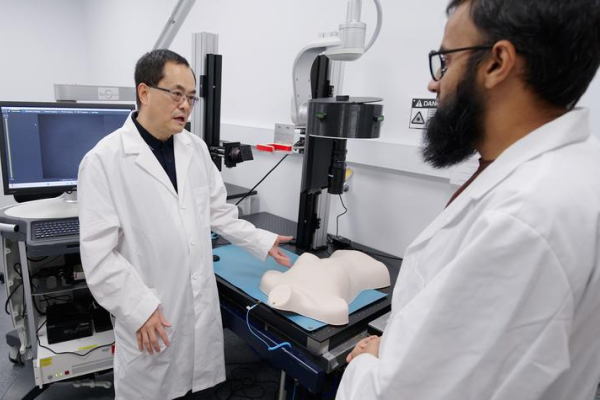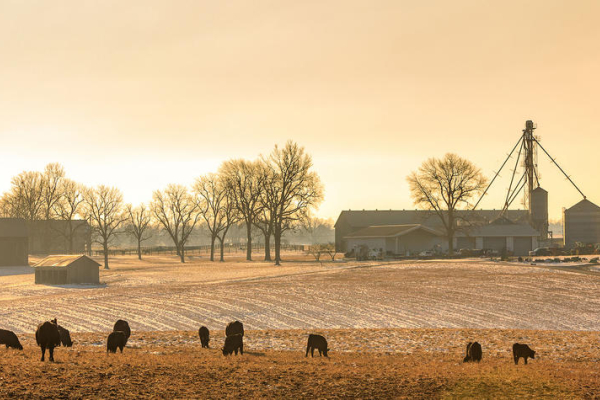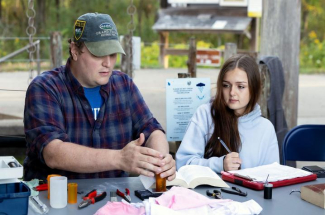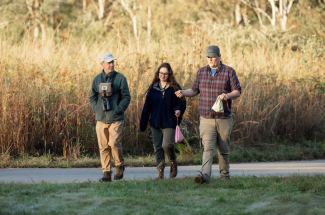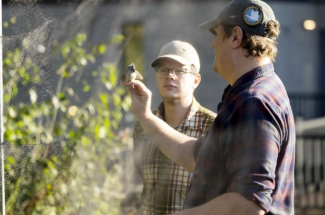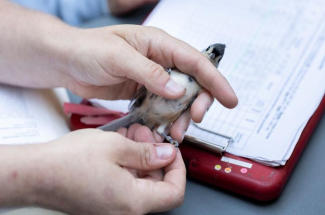‘Birds are the great unifier’: UK study on avian migration and survival takes flight
At the University of Kentucky Martin-Gatton College of Agriculture, Food and Environment (CAFE), researchers and students are studying how wildlife populations respond to conservation activities. The McNeil Lab, led by Darin “DJ” McNeil, Ph.D., assistant professor of wildlife management in the Department of Forestry and Natural Resources (FNR), focuses on researching forest birds in Kentucky and the eastern United States.
Supported by the USDA’s Natural Resource Conservation Service Conservation Effects Assessment Project grant and the McIntire-Stennis Capacity Grant, the study titled “Assessing the Value of Forest Management Practices to Native Birds of the Central Appalachian Mountains” is identifying factors that drive variation in survival rates among different avian populations. To gather data, McNeil is using a technique called bird banding — a method to capture, mark and track movement of birds with a small, numbered tag attached to their tarsus, or leg.
For lead principal investigator and master bander McNeil, who is authorized by the United States Geological Survey’s Bird Banding Lab to band wild birds, understanding birds’ population biology, managing their habitats and developing effective conservation strategies are key in ensuring this research takes flight.
“The goal is to better understand how we can protect these bird resources,” McNeil said. “If we aren’t proactive in keeping healthy forests and managing our wildlife populations, like birds, these resources can fade away and become highly degraded. It’s very important to consider the sustainability and management of our natural resources so our future generations can have access.”
In October, McNeil led a bird banding demonstration at Raven Run, a 734-acre nature sanctuary outside of Lexington, giving the public the chance to see conservation research in action. One of the key aspects of McNeil’s study is comparing survival and movement rates of bird species in rural sites like Raven Run to those in more urban environments. By studying the data collected through the bird banding process, McNeil hopes his research will help people to better understand how urbanization and other potential stressors might impact different bird populations’ overall life cycles.
“Maybe a red-headed woodpecker is more sensitive to urbanization, versus a tufted titmouse or northern cardinal, which are both ubiquitous in both urban and rural areas,” McNeil said. “These are the types of questions we are trying to answer with the data we are collecting here and in other places.”
McNeil and a group of his students, whom he affectionately refers to as “fellow bird nerds,” have banded multiple species, including the Carolina wren, Carolina chickadee, tufted titmouse and the northern cardinal — Kentucky’s state bird.
Nicole Notarianni, a student in the Forest and Natural Resource Sciences master’s program at Martin-Gatton CAFE, joined the McNeil Lab in 2023 and has been working on a habitat management project on eastern whip-poor-will habitat ecology in Pennsylvania.
For Notarianni, who plans to be a master bander in the future, working with McNeil on this study has enhanced her passion for researching birds — academically and professionally.
“He’s an incredible mentor, and there’s a reason that his office is full of students constantly,” Notarianni said. “I’ve learned so much from DJ, like learning how to publish, coding and outreach, making me very attractive to future employers. After graduating, I plan to pursue the Forest and Natural Resource Sciences Ph.D. program at the University of Kentucky.”
Will Gibson, another graduate student studying under McNeil, is researching Venus flytraps and bobwhite quail in North Carolina. For Gibson, who’s been working in the McNeil Lab since he was an undergraduate student studying the diets of Cooper's and sharp-shinned hawks, bird banding has prepared him to do more bird research.
In addition, Gibson hopes that more people walk away from outreach events like the one at Raven Run appreciating birds and wanting to become a “steward of the land.”
“Projects like [Raven Run] give our students a chance to see how it’s done and the steps we need to go through to get prepared for our careers in this field,” Gibson said. “Just being around birds — identifying them, seeing how the banding process works — is very helpful to someone like me who wants to study birds for the rest of their lives. Managing the land more properly and helping more bird species can make Kentucky and the world a better place for our wildlife.”
Going forward, McNeil hopes that this research can reshape people’s minds and the overall ecosystem in Kentucky. In addition, he believes that UK provides the “perfect setting” for current and future students who want to study the field of wildlife conservation.
“At some point, when you lose a certain number of birds, you’ll notice the woods becoming quieter and quieter,” said McNeil. “If we aren’t paying close enough attention to these bird populations, we will lose a lot of bird biodiversity, which is quite impressive in Kentucky. We must do the hard work of going out and monitoring bird populations. Students that want to get research experience, which is essential for getting a sustainable career in this field, can get it here at UK.”
“There are few other organisms that go across continents every single year,” Notarianni added. “Birds are the great unifier, and it’s awesome to see people loving birds.”
To learn more about the Department of Forestry and Natural Resources at Martin-Gatton CAFE, visit https://forestry.mgcafe.uky.edu.
This material is based upon work that is supported by the Natural Resource Conservation Service Conservation Effects Assessment Project grant, U.S. Department of Agriculture under award number 68-7482-12-502 and the National Institute of Food and Agriculture, U.S. Department of Agriculture, McIntire-Stennis Capacity Grant under award number KY009043. Any opinions, findings, conclusions or recommendations expressed in this publication are those of the author(s) and do not necessarily reflect the view of the Department of Agriculture.
